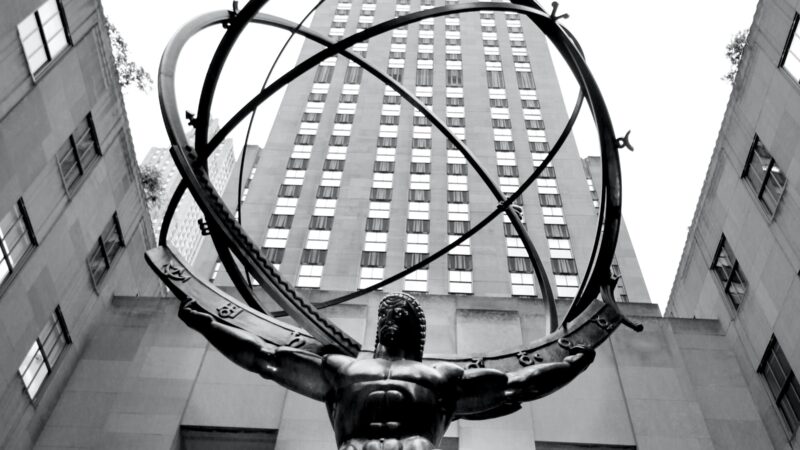John Galt, Tom Joad, and other Polemical Myths
Just about the only titles by Ayn Rand I’d feel comfortable assigning my students without previous suggestion by either student or boss would be Anthem or We the Living, mostly because they both fit into broader genres of dystopian and biographical fiction, respectively, and can, thus, be understood in context. Don’t get me wrong: I’d love to teach The Fountainhead or Atlas Shrugged, if I could find a student nuanced (and disciplined) enough to handle those two; however, if I were to find such a student, I’d probably skip Rand and go straight to Austen, Hugo, and Dostoevsky—again, in part to give students a context of the novelistic medium from which they can better understand authors like Rand.
My hesitation to teach Rand isn’t one of dismissal; indeed, it’s the opposite—I’ve, perhaps, studied her too much (certainly, during my mid-twenties, too exclusively). I could teach either of her major novels, with understanding of both plot and philosophy, having not only read and listened to them several times but also read most of her essays and non-fiction on philosophy, culture, art, fiction, etc. However, I would hesitate to teach them because they are, essentially, polemics. Despite Rand’s claiming it was not her purpose, the novels are didactic in nature: their events articulate Rand’s rationalistic, human-centric metaphysics (itself arguably a distillation of Aristotelian natural law, Lockean rights, and Nietzschean heroism filtered through Franklin, Jefferson, and Rockefeller and placed in a 20th-century American context—no small feat!). Insofar as they do so consistently, The Fountainhead and Atlas Shrugged succeed, and they are both worth reading, if only to develop a firsthand knowledge of the much-dismissed Rand’s work, as well as to understand their place in 20th-century American culture and politics.
All that to say that I understand why people, especially academics, roll their eyes at Rand (though at times I wonder if they’ve ever seriously read her). The “romantic realism” she sought to develop to glorify man as (she saw) man ought to be, which found its zenith in the American industrialist and entrepreneur, ran counter to much that characterized the broader 20th century culture (both stylistically and ideologically), as it does much of the 21st. Granted, I may have an exaggerated sense of the opposition to Rand—her books are still read in and out of the classroom, and some of her ideas still influence areas of at least American culture—and one wonders if Rand wouldn’t take the opposition, itself, as proof of her being right (she certainly did this in the last century). However, because of the controversy, as well as the ideology, that structures the novels, I would teach her with a grain of salt, not wanting to misuse my position of teaching who are, essentially, other people’s kids who probably don’t know and haven’t read enough to understand Rand in context. For this fact, if not for the reasoning, I can imagine other teachers applauding me.
And yet, how many academics would forego including Rand in a syllabus and, in the same moment, endorse teaching John Steinbeck without a second thought?
I generally enjoy reading books I happened to miss in my teenage years. Had I read The Great Gatsby any sooner than I did in my late twenties, I would not have been ready for it, and the book would have been wasted on me. The same can be said of The Scarlet Letter, 1984, and all of Dostoevsky. Even the books I did read have humbled me upon rereading; Pride and Prejudice wasn’t boring—I was.
Reading through The Grapes of Wrath for the first time this month, I am similarly glad I didn’t read it in high school (most of my peers were not so lucky, having had to read it in celebration of Steinbeck’s 100th birthday). The fault, dear Brutus, is not in the book (though it certainly has faults) but in ourselves—that we, as teenagers who lack historical, political, and philosophical context, are underlings. One can criticize Atlas Shrugged for presenting a selective, romanticized view of the capitalist entrepreneur (which, according to Rand’s premises, was thorough, correct, consistent, and, for what it was, defensible) which might lead teenagers to be self-worshipping assholes who, reading Rand without nuance, take the book as justification for mistaking their limited experience of reality as their rational self-interest. One can do much the same, though for ideas fundamentally opposed to Rand’s, for The Grapes of Wrath.
A member of the Lost Generation, John Steinbeck was understandably jaded in his view of 19th-century American ideals. Attempting to take a journalistic, modern view of the Great Depression and Dust Bowl from the bottom up, he gave voice to the part of American society that, but for him, may have remained inarticulate and unrecorded. Whatever debate can be had about the origins of Black Tuesday (arguably beginning more in Wilson’s Washington and Federal Reserve than on Wall Street), the Great Depression hit the Midwest hardest, and the justifiable sense that Steinbeck’s characters are unfair victims of others’ depredations pervades The Grapes of Wrath, just as it articulates one of the major senses of the time. When I read the book, I’m not only reading of the Joad family: I’m reading of my own grandfather, who grew up in Oklahoma and later Galveston, TX. He escaped the latter effects of the Dust Bowl by going not to California but to Normandy. I’m fortunate to have his journal from his teenage years; other Americans who don’t have such a journal have Steinbeck.
However, along with the day-in-the-life (in which one would never want to spend a day) elements of the plot, the book nonetheless offers a selectively, one might even say romantically, presented ideology in answer to the plot’s conflict. Responding to the obstacles and unfairness depicted in The Grapes of Wrath one can find consistent advocacy of revolution among the out-of-work migrants that comprise most of the book. Versus Rand’s extension of Dagny Taggart or Hank Rearden’s sense of pride, ownership, and property down to the smallest elements of their respective businesses, one finds in Steinbeck the theme of a growing disconnect between legal ownership and the right to the land.
In the different reflections interpolated throughout the Joads’ plot Steinbeck describes how, from his characters’ view, there had been a steady divorce over the years between legal ownership of the land and appreciation for it. This theme was not new to American literature. The “rural farmer vs city speculator” mythos is one of the fundamental characteristics of American culture reaching back to Jefferson’s Democratic Republicans’ opposition to Adams’s Federalists, and the tension between the southwest frontiersman and the northeast banker would play a major role in the culture of self-reliance, the politics of the Jacksonian revolution onward, and the literature of Mark Twain and others. Both sides of the tension attempt to articulate in what the inalienable right to property inheres. Is it in the investment of funds and the legal buying and owning of land, or is it in the physical production of the land, perhaps in spite of whoever’s name is on the land grant or deed? Steinbeck is firmly in the latter camp.
However, in The Grapes of Wrath one finds not a continuation of the yeoman farmer mythos but an arguable undermining of the right to property and profit, itself, that undergirds the American milieu which makes the yeoman farmer possible, replacing it with an (albeit understandable) “right” based not on production and legal ownership, but on need. “Fallow land’s a sin,” is a consistent motif in The Grapes of Wrath, especially, argue the characters, when there are so many who are hungry and could otherwise eat if allowed to plant on the empty land. Steinbeck does an excellent job effecting sympathy for the Joads and other characters who, having worked the soil their whole lives, must now compete with hundreds of others like them for jobs paying wages that, due to the intended abundance of applicants, fall far short of what is needed to fill their families’ stomachs.
Similarly, Steinbeck goes to great pains to describe the efforts of landowners to keep crop prices up by punishing attempts to illegally grow food on the fallow land or pick the fruit left to rot on trees, as well as the plot, narrowly evaded by the Joads, to eradicate “reds” trying to foment revolution in one of the Hoovervilles of the book (Tom Joad had, in fact, begun to advocate rising up against landowners in more than one instance). In contrast to the Hoovervilles and the depredations of locals against migrant Okies stands the government camp, safely outside the reach of the local, unscrupulous, anti-migrant police and fitted out with running water, beneficent federal overseers, and social events. In a theme reminiscent of the 19th-century farmers’ looking to the federal government for succor amidst an industrializing market, Steinbeck concretizes the relief experienced in the Great Depression by families like the Joads at the prospects of aid from Washington.
However, just as Rand’s depictions of early twentieth-century America is selective in its representation of the self-made-man ethos of her characters (Rand omits, completely, World War I and the 1929 stock market crash from her novels), Steinbeck’s representation of the Dust Bowl is selective in its omissions. The profit-focused prohibitions against the Joads’ working the land were, in reality, policies required by FDR’s New Deal programs—specifically the Agricultural Adjustment Act, which required the burning of crops and burying of livestock in mass graves to maintain crop prices and which was outlawed in 1936 by the Supreme Court. It is in Steinbeck’s description of this process, which avoids explicitly describing the federal government’s role therein, where one encounters the phrase “grapes of wrath,” presaging a presumable event—an uprising?—by the people: “In the souls of the people the grapes of wrath are filling and growing heavy, growing heavy for the vintage.” Furthermore, while Rand presents, if in the hypothetical terms of narrative, how something as innocuous and inevitable as a broken wire in the middle of a desert can have ramifications that reach all the way to its company’s highest chair, Steinbeck’s narrative remains focused on the Joads, rarely touching on the economic exigencies experienced by the local property and business owners except in relation to the Joads and to highlight the apparent inhumanity of the propertied class (which, in such events as the planned fake riot at the government camp dance party, Steinbeck presents for great polemical effect).
I use “class” intentionally here: though the Great Depression affected all, Steinbeck’s characters often adopt the class-division viewpoint not only of Marx but of Hegel, interpreting the various landowners’ actions as being intentionally taken at the expense of the lower, out-of-work, classes. Tom Joad’s mother articulates to Tom why she is, ultimately, encouraged by, if still resentful of the apparent causers of, their lot:
“Us people will go on living when all them people is gone. Why, Tom, we’re the people that live. They ain’t gonna wipe us out. Why, we’re the people—we go on.”
“We take a beatin’ all the time.”
“I know.” Ma chuckled. “Maybe that makes us tough. Rich fellas come up an’ they die, an’ their kids ain’t no good, an’ they die out. But, Tom, we keep a-comin’. Don’ you fret none, Tom. A different time’s comin’.”
Describing, if in fewer words than either Hegel or Marx, the “thesis-antithesis-synthesis” process of historical materialism, where their class is steadily strengthened by their adverse circumstances in ways the propertied class is not, Mrs. Joad articulates an idea that pervades much of The Grapes of Wrath: the sense that the last, best hope and strength of the put-upon lower classes is found in their being blameless amidst the injustice of their situation, and that their numbers makes their cause inevitable.
This, I submit, is as much a mythos—if a well-stylized and sympathetically presented one—as Rand’s depiction of the producer-trader who is punished for his or her ability to create, and, save for the discernible Marxist elements in Steinbeck, both are authentically American. Though the self-prescribed onus of late 19th- and early 20th-century literature was partially journalistic in aim, Steinbeck was nonetheless a novelist, articulating not merely events but the questions beneath those events and concretizing the perspectives and issues involved into characters and plots that create a story, in the folk fairy tale sense, a mythos that conveys a cultural identity. Against Rand’s modernizing of the self-made man Steinbeck resurrects the soul of the Grange Movement of farmers who, for all their work ethic and self-reliance, felt left behind by the very country they fed. That The Grapes of Wrath is polemical—from the Greek πολεμικός for “warlike” or “argumentative”—does not detract from the project (it may be an essential part of it). Indeed, for all the license and selectivity involved in the art form, nothing can give fuel to a cause like a polemical novel—as Uncle Tom’s Cabin, The Jungle, and many others show.
However, when it comes to assigning polemics to students without hesitation, I…hesitate. Again, the issue lies in recognizing (or, for most students, being told) that one is reading a polemic. When one reads a polemical novel, one is often engaging, in some measure, with politics dressed up as story, and it is through this lens and with this caveat that such works must be read—even (maybe especially!) when they are about topics with which one agrees. As in many things, I prefer to defer to Aristotle, who, in the third section of Book I of the Nicomachean Ethics, cautions against young people engaging in politics before they first learn enough of life to provide context:
Now each man judges well the things he knows, and of these he is a good judge. And so the man who has been educated in a subject is a good judge of that subject, and the man who has received an all-round education is a good judge in general. Hence a young man is not a proper hearer of lectures on political science; for he is inexperienced in the actions that occur in life, but its discussions start from these and are about these; and, further, since he tends to follow his passions, his study will be vain and unprofitable, because the end aimed at is not knowledge but action. And it makes no difference whether he is young in years or youthful in character; the defect does not depend on time, but on his living, and pursuing each successive object, as passion directs.
Of course, the implicit answer is to encourage young people (and ourselves) to read not less but more—and to read with the knowledge that their own interests, passions, neuroses, and inertias might be unseen participants in the process. Paradoxically, it may be by reading more that we can even start to read. Rand becomes much less profound, and perhaps more enjoyable, after one reads the Aristotle, Hugo, and Nietzsche who made her, and I certainly drew on American history (economic and political) and elements of continental philosophy, as well as other works of Steinbeck and the Lost Generation, when reading The Grapes of Wrath. Yet, as Aristotle implies, young people haven’t had the time—and, more importantly, the metaphysical and rhetorical training and self-discipline—to develop such reflection as readers (he said humbly and as a lifelong student, himself). Indeed, as an instructor I see this not as an obstacle but an opportunity—to teach students that there is much more to effective reading and understanding than they might expect, and that works of literature stand not as ancillary to the process of history but as loci of its depiction, reflection, and motivation.
Perhaps I’m exaggerating my case. I have, after all, taught polemical novels to students (Anthem among them, as well as, most recently, 1984 to a middle schooler), and a novel I’ve written and am trying to get published is, itself, at least partially polemical on behalf of keeping Shakespeare in the university curriculum. Indeed, Dostoevsky’s polemical burlesque of the psychology behind Russian socialism, Devils, or The Possessed, so specifically predicted the motives and method of the Russian Revolution (and any other socialist revolution) more than fifty years before it happened that it should be required reading. Nonetheless, because the content and aim of a work requires a different context for teaching, a unit on Devils or The Grapes of Wrath would look very different from one on, say, The Great Gatsby. While the latter definitely merits offering background to students, the former would need to include enough background on the history and perspectives involved to be able to recognize them. The danger of omitting background from Fitzgerald would be an insufficient understanding of and immersion in the plot, of Steinbeck, an insufficient knowledge of the limits of and possible counters to the argument.
Part of the power and danger of polemical art lies in its using a fictional milieu to carry an idea that is not meant to be taken as fiction. The willing suspension of disbelief that energizes the former is what allows the latter idea to slip in as palatable. This can produce one of at least two results, both, arguably, artistic aberrations: either the idea is caught and disbelief is not able to be suspended, rendering the artwork feeling preachy or propagandistic, or the audience member gives him or herself over to the work completely and, through the mythic capability of the artistic medium, becomes uncritically possessed by the idea, deriving an identity from it while believing they are merely enjoying and defending what they believe to be great art. I am speaking from more than a bit of reflection: whenever I see some millennial on Twitter interpret everything through the lens of Harry, Ron, and Hermione, I remember mid-eye-roll that I once did the same with Dagny, Francisco, and Hank.
Every work of art involves a set of values it seeks to concretize and communicate in a certain way, and one culture’s mythos may be taken by a disinterested or hostile observer to be so much propaganda. Because of this, even what constitutes a particular work as polemical may, itself, be a matter of debate, if not personal taste. One can certainly read and gain much from reading any of the books I’ve mentioned (as The Grapes of Wrath‘s Pulitzer Prize shows), and, as I said, I’m coming at Grapes with the handicap of its being my first read. I may very well be doing what I warn my students against doing, passing judgment on a book before I understand it; if I am, I look forward to experiencing a well-deserved facepalm moment in the future, which I aim to accelerate by reading the rest of Steinbeck’s work (Cannery Row is next). But this is, itself, part of the problem—or boon—of polemics: that to avoid a premature understanding one must intentionally seek to nuance their perspective, both positively and negatively, with further reading.
Passively reading Atlas Shrugged or The Grapes of Wrath, taking them as reality, and then interpreting all other works (and, indeed, all of life) through their lens is not dangerous because they aren’t real, but because within the limits of their selective stylization and values they are real. That is what makes them so powerful, and, as with anything powerful, one must learn how to use them responsibly—and be circumspect when leading others into them without also ensuring they possess the discipline proper to such works.










